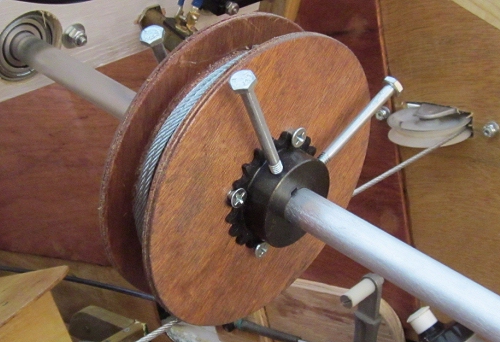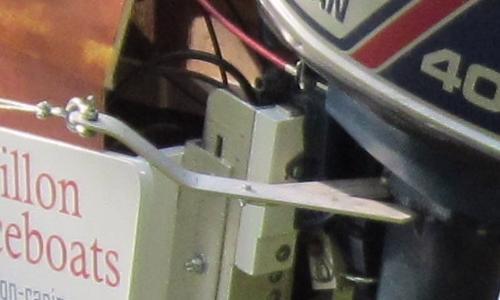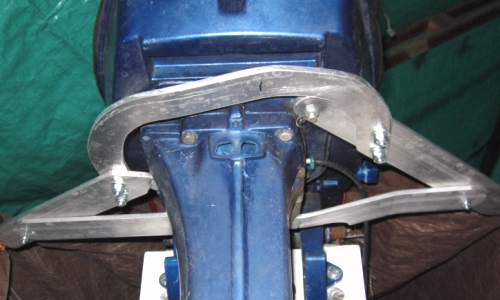Previous Page --
INDEX --
Next Page
Mini Tunnel (Redesigned Version) Boat Plans
Page Twelve
Steering System
Most of the photos below are borrowed from the Dillon EZ Tunnel Construction Notes.
The steering system starts with a 3/4-inch diameter metal steering shaft mounted on bearings bolted to the dashboard and cowling bulkhead. Install the dashboard bearing as close to bottom edge of the dashboard as is practical. The other bearing should be installed as close to the top edge of the cowling bulkhead as is practical.
The steering drum, mounted on the shaft, spools the 1/8-inch cable which runs through coaming pulleys and then aft to the steering arms on the motor.
I have found that 3/4-inch steel rod, of the sort you can typically get at hardware stores, fits 3/4-inch bearings and other components quite accurately. Aluminim rod, on the other hand, tends to be over-sized and has to be laboriously sanded down to make it fit. The aluminum rod is about 3 lbs. lighter than the steel. If the weight savings is important to you, then go with the aluminum and do the work.
I purchased my steering bearings from Surplus Center in Lincoln, NE. (I will mention other components available at Surplus Center later in these notes.)

Steering drums can be purchased at places like Brown Tool & Machine and Sorenson Woodcraft.
I've gotten into the habit of making my own from plywood discs. Four or five 5-inch discs are sandwiched between two 6-inch discs. A 3/4" hole is drilled through. Two sprockets (or pulley wheels) are screwed to the drum to provide attachment to the steering shaft. I like to replace the set screws in the sprockets with bolts for easier tightening.
These sprockets, from Surplus Center, are not described by their diameter, but by number of teeth and pitch. The sprocket shown is 20-Tooth, 35-Pitch.

Coaming pulleys are also available at Brown Tool & Machine and Sorenson Woodcraft.
Note that the cable emerges from the bottom of the steering drum and intersects the coaming at a 90-degree angle. Thus, you will want to purchase coaming pulleys with a 90-degree base.

The cable emerges from the coaming, through the coaming pulleys, and then rises toward the steering arms on the motor. You will need to know, at least generally, the height of your steering arm ends before mounting the coaming pulleys.

The steering cables are bent around thimbles and clamped with two cable clamps each side. The thimbles are attached to the steering arms with shackles.

These steering arms are made from 1/4" X 2" aluminum bar.
These steering arms take advantage of powerhead bolts to attach to the motor.
The arms are approximately 24 inches long; the distance between shackles is approximately 36 inches. Set up the arms so that the shackles are directly opposite the tilt tube on the motor. That way, cable tension will not change as the motor is trimmed up or down.
I know a guy who at one time had CNC-manufactured steering arms for Sport C motors. Contact me if you are interested.

The steering arms themselves attach to the motor as far aft as possible. Bracing pieces tie them to bolts farther forward.
An additional piece ties the two arms together around the back of the motor, offering more bracing and a safety factor in the event one of the arms breaks.

I like a steering wheel in the 11-inch to 12-inch diameter range. A good example is the Grant 334 which is available on Ebay through such sellers as Jegs and Summit. May also be available on Amazon.
The steering wheel is mounted on the steering shaft using a quick-release hub. These are also available on Ebay, and through dealers of racing equipment.
The fixed part of the quick-release hub is attached to the steering shaft by drilling a 1/4-inch hole through the part and the shaft and tapping in a 1-inch long roll pin.

Previous Page --
INDEX --
Next Page